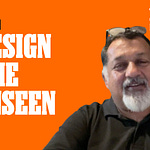Summary
In this episode of The Gyaan Project (Ep 182), artist and type designer Hanif Kureshi (12 October 1982 – 22 September 2024), co-founder of St+art India, reflects on the rise of street art in India. From graffiti’s rebellious roots to murals that transformed Lodhi Colony and Sassoon Dock, Hanif shares how public art builds identity and community. A must-listen for designers, artists, and urban thinkers.
Topics discussed in the episode
How do you define graffiti and street art? How are they different?
What was the early perception of graffiti in India and how did it evolve into murals?
How did St+art India begin and what role did it play in shaping public art?
How do you pick a subject or theme for a mural?
Can you share examples like the Delhi Police Headquarters or Lodhi Colony murals?
What are the pros and cons of street art reshaping urban spaces?
How has street art contributed to Swachh Bharat Abhiyan and smart city projects?
What makes India’s relationship with wall art unique or traditional?
What do you see as the future of street art in India and its smaller cities?
What is your message to young artists who wish to start creating on the streets?
What is the long term future of St+art movement?












